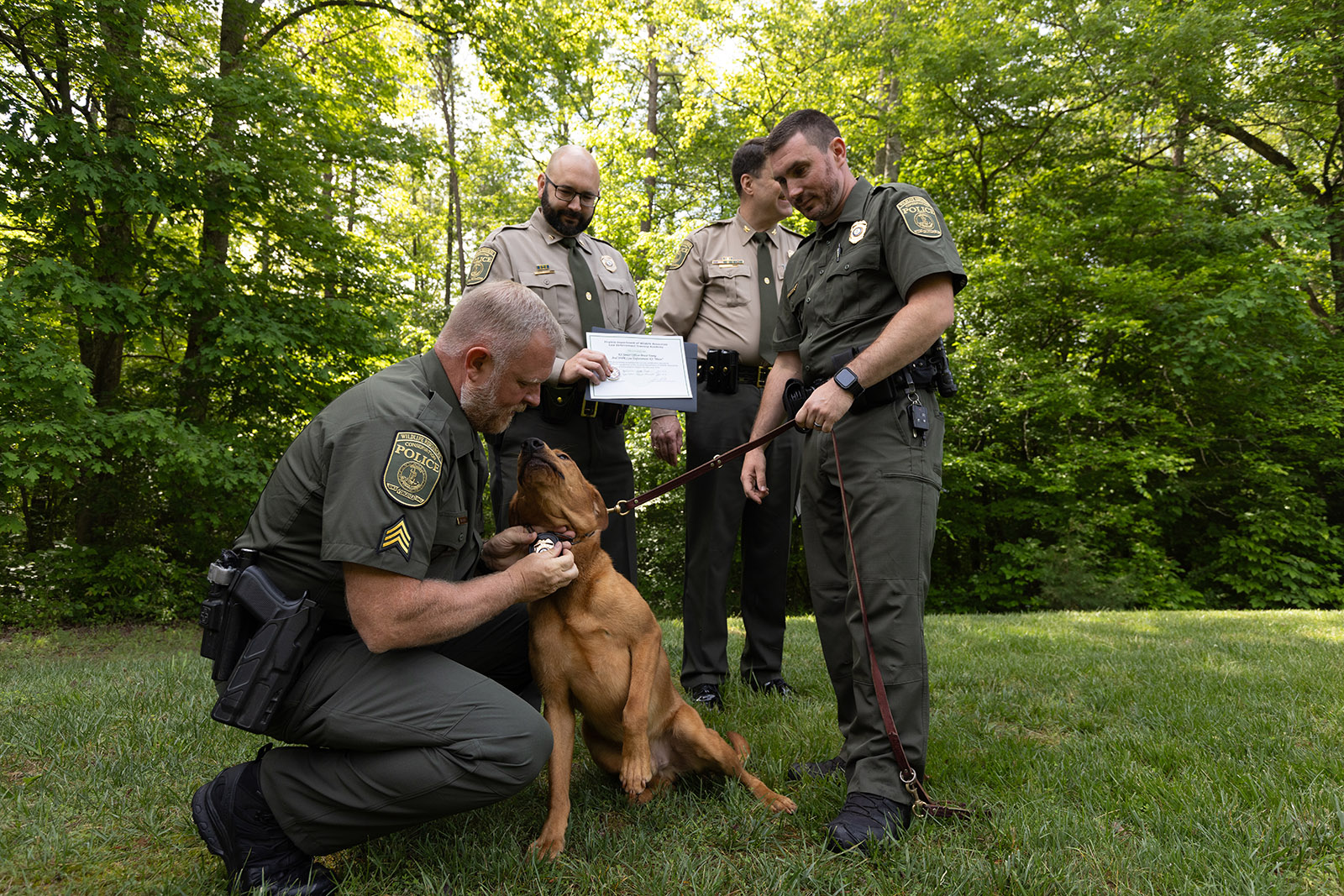By Molly Kirk/DWR
Photos by Meghan Marchetti/DWR
Two Virginia Conservation Police Officers and their canine partners graduated on May 10 from their nine-week training course to join the Virginia Department of Wildlife Resources (DWR) Conservation Police K9 Program.
Senior Officer Bruce Young and K9 Blaze will be working in Region 2, Henry County, while Master Officer Cameron Dobyns and K9 Atlas will work in Region 1, Essex County. Those two DWR teams were joined by a West Virginia Department of Natural Resources (DNR) K9 officer for the training, as the DWR Conservation Police work with the West Virginia DNR to assist them with their K9 training. Corporal Aaron Clevenger and K9 Ziva from West Virginia DNR also earned their certification alongside the DWR pairs.

(From left) Corporal Aaron Clevenger and K9 Ziva from West Virginia DNR, Senior Officer Bruce Young and K9 Blaze, and Master Officer Cameron Dobyns and K9 Atlas.
“They all did really well. It’s a lot of work for each handler and dog,” said DWR Conservation Police Sergeant Richard Howald, who is a veteran of the DWR K9 force and leads the K9 training program. Howald and two other DWR K9 officers who were the first group to join DWR’s K9 program in 2011 trained at the K9 Academy at the Indiana Department of Natural Resources, an established training program utilized by law enforcement from all over the United States. In the years since, DWR K9 officers and dogs have trained both in Indiana and internally in DWR. In 2012, Howald trained two more K9 teams to join the program within DWR, and in the spring of 2020 Howald conducted an internal training program of five K9 officers and dogs into the DWR program. DWR has also sent K9 officers to the Indiana DNR program to act as instructors.
“You’re trying to train a dog to do a task. But you’re also training the handler how to train the dog to do the task. And then you’re trying to combine them to work together,” Howald noted of the training process that began in February. “It’s quite a bit of work to make all that happen. But you can see huge progression even on one day. This group progressed really well.”

DWR Sergeant Richard Howald (left) advising as Master Officer Cameron Dobyns and K9 Atlas train in tracking.
DWR added the two K9 teams to the force after the retirement of K9 Bailey when former CPO Jim Patrillo took another position at DWR and Howald was promoted to Sergeant, limiting his time for work in the field. The K9 program now has nine K9 teams working statewide.
“The K9 handlers and their dogs are a tremendous asset to the agency and support not only the mission of DWR, but the public safety mission of our partner agencies across the commonwealth; they are a true force multiplier,” said Major Ryan Shuler, deputy chief of law enforcement of the Virginia Conservation Police. “Their abilities to locate articles and evidence and track suspects and missing persons enhance our ability to protect Virginia’s wildlife resources and citizens. We’re excited to have Senior Officer Bruce Young with K9 Blaze and Master Officer Cameron Dobyns with K9 Atlas joining the DWR K9 program.”

Sergeant Richard Howald (left) attaches the DWR Conservation Police badge to K9 Blaze’s collar as Senior Officer Bruce Young (right) holds him.
Howald found both Blaze, who is a full brother from another litter to current DWR K9 Coal, and Atlas, who came from Mobile, Alabama. “These dogs have to have play drive and prey drive, they’ve got to want to re-engage the handler, and generally be a pretty smart dog,” Howald said.
Howald noted that Blaze and Atlas are “totally different personalities. They’re both super smart and workers. One works extremely fast. He’s a hard-working dog. But a dog working really fast could miss something. And then the other dog works very smoothly and consistently, but if the handler puts too much pressure on a dog like that, it could cause it to take it as a correction. I always tell the handlers, ‘work your dog, don’t worry about what the other dogs are doing or how the other handler is working in their dog.’”
Howald notes that the K9 handlers and dogs never stop improving as they work in the field. “It’s a daily process of work and small progressions every day to get better. It’s a constant learning process the whole time,” he said.

Senior Officer Bruce Young and K9 Blaze

Master Officer Cameron Dobyns and K9 Atlas

